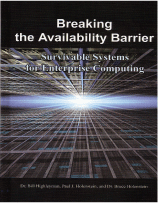- About
- Solutions
- Essentials
- Utilities
- Publications
- Product Delivery
- Support

This book describes the techniques that can be used today for extending the time between system failures from years to centuries, often at little or no additional cost. For more information about this book series, please contact us.
Purchase Breaking the Availability Barrier, Volume I (2004: ISBN 1-4107-9233-1)
Chapter 1 of Breaking the Availability Barrier Volume I examines how to measure reliability, compare reliability between operating systems, and increase availability and reliability in fault-tolerant systems such as HPE NonStop systems. The audio discusses the percent of availability in terms of the number of 9s, whether it is five 9s (.99999), a little less than three 9s (.998), or a little more than four nines (.99992). The goal is to meet the required number of 9s needed for applications to function efficiently.
Free MP3 Audio: Breaking the Availability Barrier, Chapter 1 – The 9s Game
An active/active system is a network of independent processing nodes cooperating in a common application. Should a node fail, one only needs to switch over that node’s users to a surviving node. Recovery is in subseconds to seconds.
You will learn about actual successful installations of active/active systems. This book is for the IT executives who must reduce the downtime of their systems, for the system architects who are charged with significantly improving the availability of their systems, and for the operations staff who must manage and operate these systems.
The authors of the book, Dr. Bill Highleyman, Paul J. Holenstein, and Dr. Bruce Holenstein, have a combined experience of over 100 years in the implementation of fault-tolerant, highly available computing systems. This experience ranges from the early days of custom redundant systems to today’s fault-tolerant offerings from HPE NonStop and Stratus. Learn more about the authors.
